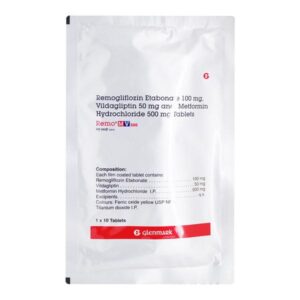METFORMIN + VILDAGLIPTIN + REMOGLIFLOZIN
Metformin: Metformin is an oral medication used to treat type 2 diabetes. It is also sometimes prescribed off-label for conditions like polycystic ovary syndrome (PCOS) and gestational diabetes. Metformin belongs to a class of medications known as biguanides.
The primary mechanism of action of metformin is to decrease glucose production in the liver and improve insulin sensitivity in the muscles and fat cells. It does this by inhibiting the production of glucose by the liver and increasing the uptake and utilization of glucose by cells.
The usual starting dose of metformin is 500 mg twice a day, taken with meals. The dose can be gradually increased to a maximum of 2,000 mg per day, depending on individual response and tolerability. Extended-release formulations are also available which allow for once-daily dosing.
Common side effects of metformin include gastrointestinal disturbances such as diarrhea, nausea, and stomach upset. These side effects usually subside as the body adjusts to the medication. Other less common side effects may include taste disturbances, weakness, muscle pain, and lactic acidosis (a rare but serious side effect). Lactic acidosis is more likely to occur in people with kidney or liver problems, or in those who misuse alcohol.
It is important to note that metformin is generally considered safe and well-tolerated. However, it should not be used in individuals with severe kidney disease or conditions that may increase the risk of lactic acidosis, such as liver disease or excessive alcohol consumption. Before starting metformin, it is crucial to discuss any existing medical conditions and medications with a healthcare professional to ensure its safe use.
Vildagliptin: Vildagliptin is an oral antidiabetic medication used to treat type 2 diabetes. It is sold under the brand names Galvus and Zomelis.
The mechanism of action of vildagliptin is through inhibition of the enzyme dipeptidyl peptidase-4 (DPP-4), which results in an increase in levels of the hormone glucagon-like peptide-1 (GLP-1) and glucose-dependent insulinotropic polypeptide (GIP). These hormones help regulate blood sugar levels by increasing insulin secretion and decreasing glucagon release.
The recommended starting dose of vildagliptin is usually 50 mg taken orally twice daily, although the specific dose may vary depending on the individual’s needs and response. It can be taken with or without food.
Some common side effects of vildagliptin include headache, dizziness, hypoglycemia (low blood sugar), nasopharyngitis (common cold symptoms), upper respiratory tract infection, and gastrointestinal symptoms such as nausea, diarrhea, and abdominal pain. These side effects are generally mild and transient.
Rare but serious side effects of vildagliptin may include pancreatitis (inflammation of the pancreas), allergic reactions, and hepatotoxicity (liver damage). If any of these severe side effects occur, medical attention should be sought immediately.
It is important to note that vildagliptin should not be used in patients with type 1 diabetes or diabetic ketoacidosis. As with any medication, it is crucial to follow the prescribed dose and consult with a healthcare provider for personalized guidance and monitoring while taking vildagliptin.
Remogliflozin: Remogliflozin is a drug that belongs to the class of sodium-glucose co-transporter 2 (SGLT2) inhibitors. It is primarily used for the treatment of type 2 diabetes mellitus.
The mechanism of action of remogliflozin involves the inhibition of SGLT2, a protein responsible for reabsorbing glucose from the kidneys back into the bloodstream. By blocking this protein, remogliflozin enables the excretion of excess glucose through urine, resulting in lower blood glucose levels. This mechanism is independent of insulin and can be used either alone or in combination with other antidiabetic medications.
The usual recommended dose of remogliflozin is 100-250 mg once daily, either with or without food. The specific dosage may vary depending on individual factors such as renal function and response to the medication. It is crucial to adhere to the prescribed dose and consult a healthcare professional for specific dosage instructions.
Like any medication, remogliflozin may cause side effects. The most commonly reported side effects include urinary tract infections, genital mycotic (fungal) infections, and increased urination. Other potential side effects may include hypoglycemia (especially when used in combination with insulin or sulfonylureas), dehydration, dizziness, fatigue, and increased LDL cholesterol levels. It is important to discuss any concerning side effects with a healthcare provider.
It is essential to note that although remogliflozin may help control blood glucose levels, it is not a substitute for a healthy lifestyle, including regular exercise and a proper diet. Regular monitoring of blood glucose levels and routine check-ups with a healthcare professional are also crucial to ensure optimal management of diabetes.

